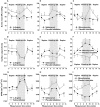Non-invasive measurement of the haemodynamic effects of inhaled salbutamol, intravenous L-arginine and sublingual nitroglycerin
- PMID: 19660000
- PMCID: PMC2732937
- DOI: 10.1111/j.1365-2125.2009.03434.x
Non-invasive measurement of the haemodynamic effects of inhaled salbutamol, intravenous L-arginine and sublingual nitroglycerin
Abstract
Aims: To examine the effects of salbutamol and L-arginine, two compounds acting largely on the endothelium, and the endothelium-independent agent nitroglycerin on blood pressure, arterial compliance, cardiac function and vascular resistance.
Methods: Continuous radial pulse wave analysis, whole-body impedance cardiography, and plethysmographic blood pressure from fingers in the supine position and during head-up tilt were recorded in nine healthy subjects. Data were captured before and after L-arginine (10 mg mg(-1) min(-1)) or saline infusion, salbutamol (400 microg) or placebo inhalation, and sublingual nitroglycerin (0.25 mg) or placebo resoriblet.
Results: The results of all measurements were comparable before drug administration. The effects of inhaled salbutamol were apparent in the supine position: systemic vascular resistance (-9.2 +/- 2.6%) and augmentation index (-4.0 +/- 1.5%) decreased, and heart rate (8.6 +/- 2.5%) and cardiac output (8.8 +/- 3.1%) increased. L-arginine had no clear effects on supine haemodynamics, but during head-up tilt blood pressure was moderately decreased and reduction in aortic reflection time prevented, indicating improved large arterial compliance. Nitroglycerin reduced supine vascular resistance (-6.7 +/- 1.8%) and augmentation index (-7.4 +/- 1.6%), and increased cardiac output (+9.2 +/- 2.7%). During head-up tilt, nitroglycerin increased cardiac output (+10.6 +/- 5.6%) and heart rate (+40 +/- 7.5%), decreased vascular resistance (-7.8 +/- 5.8%) and augmentation index (-18.7 +/- 3.2%), and prevented the decrease in aortic reflection time.
Conclusions: Inhaled salbutamol predominantly changed supine haemodynamics, whereas the moderate effects of L-arginine were observed during the head-up tilt. In contrast, small doses of nitroglycerin induced major changes in haemodynamics both supine and during the head-up tilt. Altogether, these results emphasize the importance of haemodynamic measurements in both the supine and upright positions.
Figures


Similar articles
-
Supine and upright haemodynamic effects of sublingual nitroglycerin and inhaled salbutamol: a double-blind, placebo-controlled, randomized study.J Hypertens. 2012 Feb;30(2):297-306. doi: 10.1097/HJH.0b013e32834e4b26. J Hypertens. 2012. PMID: 22179079 Clinical Trial.
-
Salbutamol-induced Decrease in Augmentation Index is Related to the Parallel Increase in Heart Rate.Basic Clin Pharmacol Toxicol. 2018 Aug;123(2):161-173. doi: 10.1111/bcpt.12988. Epub 2018 Mar 30. Basic Clin Pharmacol Toxicol. 2018. PMID: 29476697
-
Reduced systemic vascular resistance in healthy volunteers with presyncopal symptoms during a nitrate-stimulated tilt-table test.Br J Clin Pharmacol. 2011 Jan;71(1):41-51. doi: 10.1111/j.1365-2125.2010.03794.x. Br J Clin Pharmacol. 2011. PMID: 21143500 Free PMC article.
-
Afterload reduction and cardiac performance. Physiologic basis of systemic vasodilators as a new approach in treatment of congestive heart failure.Am J Med. 1978 Jul;65(1):106-25. doi: 10.1016/0002-9343(78)90700-3. Am J Med. 1978. PMID: 99030 Review.
-
Nitrates, arterial function, wave reflections and coronary heart disease.Adv Cardiol. 2007;44:302-314. doi: 10.1159/000096749. Adv Cardiol. 2007. PMID: 17075217 Review.
Cited by
-
Value of nitroglycerin test in the diagnosis of heart failure in emergency department patients with undifferentiated dyspnea.Clin Cardiol. 2021 Jul;44(7):932-937. doi: 10.1002/clc.23615. Epub 2021 Jun 2. Clin Cardiol. 2021. PMID: 34076282 Free PMC article.
-
Endothelium in pharmacology: 30 years on.Br J Pharmacol. 2009 Jun;157(4):491-3. doi: 10.1111/j.1476-5381.2009.00366.x. Br J Pharmacol. 2009. PMID: 19630830 Free PMC article.
-
The Effect of Betaine on Nitrate and Cardiovascular Response to Exercise.Int J Exerc Sci. 2017 Jul 1;10(4):550-559. doi: 10.70252/XTOO5967. eCollection 2017. Int J Exerc Sci. 2017. PMID: 28674599 Free PMC article.
-
Assessing hemodynamics from the photoplethysmogram to gain insights into vascular age: a review from VascAgeNet.Am J Physiol Heart Circ Physiol. 2022 Apr 1;322(4):H493-H522. doi: 10.1152/ajpheart.00392.2021. Epub 2021 Dec 24. Am J Physiol Heart Circ Physiol. 2022. PMID: 34951543 Free PMC article. Review.
-
Liquorice ingestion attenuates vasodilatation via exogenous nitric oxide donor but not via β2-adrenoceptor stimulation.PLoS One. 2019 Oct 18;14(10):e0223654. doi: 10.1371/journal.pone.0223654. eCollection 2019. PLoS One. 2019. PMID: 31626649 Free PMC article.
References
-
- Feletou M, Vanhoutte PM. Endothelium-derived hyperpolarizing factor: where are we now? Arterioscler Thromb Vasc Biol. 2006;26:1215–25. - PubMed
-
- Landmesser U, Hornig B, Drexler H. Endothelial function: a critical determinant in atherosclerosis? Circulation. 2004;109(21) Suppl. 1:II27–33. - PubMed
-
- Rumbaut RE, Slaff DW, Burns AR. Microvascular thrombosis models in venules and arterioles in vivo. Microcirculation. 2005;12:259–74. - PubMed
-
- Rabasseda X. New joint European Hypertension/European Society of Society of Cardiology guidelines for the management of arterial hypertension. Timely Top Med Cardiovasc Dis. 2007;11:E18. - PubMed
-
- Graham I, Atar D, Borch-Johnsen K, Boysen G, Burell G, Cifkova R, Dallongeville J, De Backer G, Ebrahim S, Gjelsvik B, Herrmann-Lingen C, Hoes A, Humphries S, Knapton M, Perk J, Priori SG, Pyorala K, Reiner Z, Ruilope L, Sans-Menendez S, Op Reimer WS, Weissberg P, Wood D, Yarnell J, Zamorano JL, Walma E, Fitzgerald T, Cooney MT, Dudina A, Vahanian A, Camm J, De Caterina R, Dean V, Dickstein K, Funck-Brentano C, Filippatos G, Hellemans I, Kristensen SD, McGregor K, Sechtem U, Silber S, Tendera M, Widimsky P, Zamorano JL, Altiner A, Bonora E, Durrington PN, Fagard R, Giampaoli S, Hemingway H, Hakansson J, Kjeldsen SE, Larsen L, Mancia G, Manolis AJ, Orth-Gomer K, Pedersen T, Rayner M, Ryden L, Sammut M, Schneiderman N, Stalenhoef AF, Tokgozoglu L, Wiklund O, Zampelas A. European guidelines on cardiovascular disease prevention in clinical practice: full text. Fourth Joint Task Force of the European Society of Cardiology and other societies on cardiovascular disease prevention in clinical practice (constituted by representatives of nine societies and by invited experts) Eur J Cardiovasc Prev Rehabil. 2007;14(Suppl. 2):S1–113. - PubMed
Publication types
MeSH terms
Substances
LinkOut - more resources
Full Text Sources
Miscellaneous

